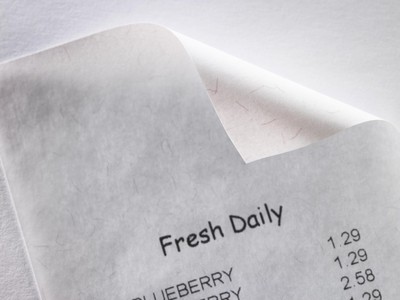Following on Clark’s post from yesterday, here’s a rare bit of good news for anyone concerned about bisphenol-A (BPA). With a small kiddo in my house, I’ve gone to a fair amount of trouble to limit our exposure to BPA. I’ve sworn off canned food, bought glass storage containers and tried to make sure most of the plastic that goes in her mouth is BPA-free. But I’ve been minorly plagued by the idea that every store receipt I touched while I was pregnant smeared the endocrine-disrupting chemical all over my fingers, not to mention the wallet and purses I used to stuff them into. Oh well.
 But within the next few months, hopefully we’ll be able to tell which cash register, credit card and ATM receipts are free of BPA. Just look for subtle red flecks on the receipt paper.
But within the next few months, hopefully we’ll be able to tell which cash register, credit card and ATM receipts are free of BPA. Just look for subtle red flecks on the receipt paper.
Appleton Papers, which produces 50 percent of the “thermal paper” used for receipts in the US and Canada, says it voluntarily removed BPA from its process in 2006 after a stream of toxicity reports and research papers raised health concerns about the chemical (which has been linked to everything from atypical gender behavior in toddlers to sterility in worms.) But until now there’s been no way for consumers to tell where their receipts come from, or which contain BPA. So Appleton decided to embed their thermal paper with small red rayon fibers, letting consumers and cashiers know a receipt is BPA-free.
(As background, a study earlier this summer from Environmental Working Group found BPA in 40 percent of receipts collected from grocery stores, gas stations, fast food restaurants and large retailers across the US. A recent study from Europe found 11 out of 13 receipts tested had BPA.)
Appleton says all of its BPA-free receipt paper should be embedded with red flecks by next March. I’m no toxicologist and can’t say for sure what risk BPA in receipts poses to me, or my two-year-old. But as a mom, my general strategy is to avoid exposing her to weird chemicals when I can. So, for now, if I don’t see red flecks on my receipts, they’re not going anywhere near my pockets. And, more importantly, it’ll give me—and other consumers—an opening to ask stores that are still using BPA-laden receipts to switch to a safer alternative.
Update: Since this post ran, I’ve had several people ask me whether the substitute chemical in these new receipts is any better than BPA. Looks like the jury is still out on that question.
Receipt image courtesy of Appleton Paper.







